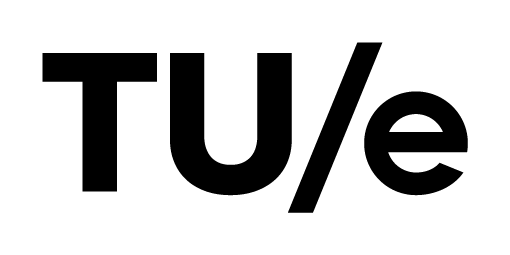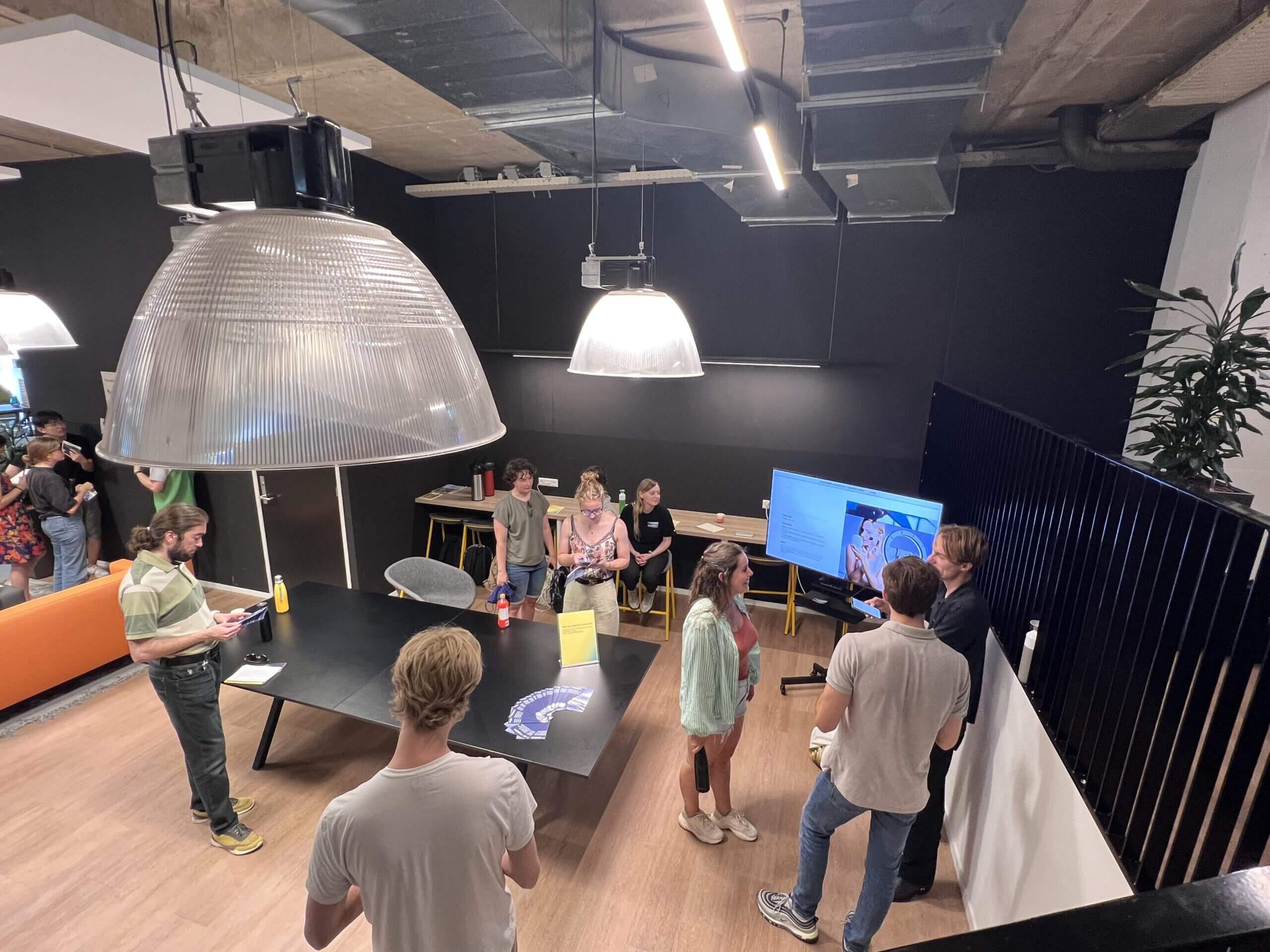

















Welcome to Researching the Future Everyday, an Industrial Design
Master’s elective at TU/e. You are about to see six glimpses of 2038—
or, rather, 02038, to use the notation proposed by the Long Now
Foundation—from design students who have spent the last eight weeks exploring different ways of imagining change over the next 15 years.
Download the exhibition catalogue (PDF), read the project briefs (The Time-Travellers, Meet The (Un)Predictables, and Challenging consumerism by design), and see the projects here:
- Will you work for Future X? Selling your soul to capitalism and forsaking a sustainable future by Enzo Li, Luna Snelder, Ioana Ştefănescu
- Children’s book from the future: What if your future child sends you a book to read? By Elke van Dael, Hanna van Rixtel, Anusha Ravishankar, Vere Vreeswijk
- Morning Assist: Finding the best suitable 2038 AI system to achieve your optimal health By Robyn Huiting, Bram Willems, Hongbin Su
- Virtual Nanny: What will the place of an autonomous A.I. in our lives be? How will that feel? By Geert Boer, Kaj Coolen, Hao-Xuan Lu
- Powerless politics: Unplugging energy dependency: how would
you choose to live without electricity? By Youp Ferket, Floris Thoonen, Nathalie Kamp - HeartRinse: If technology convenience leads to separation in relationships, what can we do to offer an opportunity to connect with others in the future? By Bente Derksen, Jules van Gurp, Leqi Wang
Background
When we imagine “the future” we are not acting in isolation: we are
doing our imagining in a broad sociological and cultural context which
influences what we believe to be possible or desirable. As designers,
we are also often in a position to make “our” visions of futures come into being, in conjunction with technological innovation, but also against a backdrop of a world facing significant crises and transitions, in climate, health, inequality, social justice, and biodiversity loss. How can we negotiate these vast questions responsibly?
This course combines a speculative and critical design approach,
drawing on work in experiential futures, with insights from other
disciplines, in the arts, humanities, and social sciences (and in fiction)
addressing aspects of how people imagine everyday life in different
futures. This enables using design methods to explore alternative,
transformative perspectives on futures, with a foundation of knowledge and insights beyond design itself.
The three broad theme briefs set for the projects each engages with
research being undertaken by the teaching staff, and we have made use of these links during the course, for example with visits from researchers on the IMAGINE: Contested Futures of Sustainability and the Centre for Unusual Collaborations ‘Playing With The Trouble’ project. Not everything we have covered over our eight weeks together has been directly applicable to the projects, but we hope that it has increased the students’ repertoire of ways of thinking about the world, ultimately informing their practice.
Mainstream design education and practice often carry taken-for-granted ideas about relations between design and changes in everyday life, usually centred on a model of “the user” which neglects wider societal and cultural dimensions, and questions of responsibility. Interaction designers have much to learn from other disciplines, in terms of insights on the impact of design on everyday life, and theoretical perspectives on these relations; equally, designers, by materialising imagination and making it experiential and engageable-with, and using design methods to enable others to imagine and express their own imaginations, have something distinct to offer the field of futures. By combining knowledge from other domains with designerly approaches to ‘futures’, the course (hopefully) guided and equipped students with knowledge, skills and attitudes required to address our current and future societal and global challenges in new ways.
We’re proud of what they have created. We hope you will enjoy these six glimpses of possible futures—but also that they will make you think.
Dan Lockton, Lenneke Kuijer, and Emilia Viaene
June 2023
Some references we’ve used
- Aldrich, F.K. (2003). Smart Homes: Past, Present and Future. In: Harper, R. (eds) Inside the Smart Home. Springer, London.
- Björneborn, L. (2020). Adjacent Possible. In: V. P. Glăveanu (ed.), The Palgrave Encyclopedia of the Possible. Springer.
- Bland, J. and Westlake, S. (2013). Don’t stop thinking about tomorrow: A modest defence of futurology. Nesta.
- Candy, S. and Kornet, K. (2019). Turning Foresight Inside Out: An Introduction to Ethnographic Experiential Futures. Journal of Futures Studies, 2019, 23(3): 3–22
- Chatting, D. (2023) Automated Indifference. interactions 30, 2 (March – April 2023), 22–26.
- Dahlgren, K, et al. “Personalization and the Smart Home: questioning techno-hedonist imaginaries.” Convergence 27.5 (2021): 1155-1169.
- Fisher, M. (2014). ‘The Slow Cancellation of the Future’ in Ghosts Of My Life: Writings on Depression, Hauntology and Lost Futures. Zero Books.
- Hayward, P. and Candy, S. (2017). The Polak Game, Or: Where Do You Stand? Journal of Futures Studies 22(2): 5–14
- Hebrok, M., Mainsah, H. (2022). Skinny as a Bird: Design fiction as a vehicle for reflecting on food futures. Futures, Volume 141, 102983.
- Holbert, N., Dando, M., Correa, I. (2020). Afrofuturism as critical constructionist design: building futures from the past and present, Learning, Media and Technology, 45:4, 328-344.
- Howell, N., Schulte, B.F., Twigger Holroyd, A., Fatás Arana, R., Sharma, S., Eden, G. (2021). Calling for a Plurality of Perspectives on Design Futuring: An Un-Manifesto. CHI’21 Extended Abstracts.
- Jensen, R.H., Strengers, Y., Raptis, D., Nicholls, L., Kjeldskov, J., and Skov, M.B. (2018) Exploring Hygge as a desirable design vision for the sustainable smart home. Proc. of the 2018 Designing Interactive Systems Conference. ACM, New York, 355–360.
- Kuijer, L. (2019). “Automated artefacts as co- performers of social practices: washing machines, laundering and design.” Social Practices and Dynamic Non-Humans. Palgrave Macmillan, Cham. 193-214.
- Kuijer, L. (2022). Extending possible futures of summer comfort in Dutch households: Phase 2 report Anticipating the role of smart technologies in the dynamics of everyday life
- Latour, B. (1992). “Where are the missing masses? The sociology of a few mundane artifacts.” Shaping technology/building society: Studies in sociotechnical change 1: 225-258.
- Lockton, D. and Candy, S. (2018). ‘A Vocabulary for Visions in Designing for Transitions’. DRS 2018: Design Research Society, 25–28 June 2018, Limerick
- Mangnus, A.C., Oomen, J., Vervoort, J.M., Hajer, M.A. (2021). Futures literacy and the diversity of the future. Futures 132
- Millward-Hopkins, J.; Steinberger, J. K.; Rao, N. D.; Oswald, Y. (2020). Providing decent living with minimum energy : A global scenario. Global Environ. Change, 65, 102168.
- Monticelli, L. (2021). On the necessity of prefigurative politics. Thesis Eleven. 167(1), 99–118.
- Pirgmaier, E. (2020) “Consumption corridors, capitalism and social change.” Sustainability: Science, Practice and Policy 16.1: 274-285.
- Reckwitz, A. (2002). Toward a Theory of Social Practices. Eur. J. Soc. Theor. 5, 243–263.
- Sahakian, M. (2018) “Constructing normality through material and social lock-in: The dynamics of energy consumption among Geneva’s more affluent households.” Demanding energy. Palgrave Macmillan, Cham, 51-71.
- Schwartz Cowan, R. (1976). “The “Industrial Revolution” in the Home: Household Technology and Social Change in the 20th Century.” Technology and Culture 17 (1):1-23.
- Strengers, Y. (2023) Resource Man and the Smart Wife: Implications for Sustainability in the Home. interactions 30, 2 (March – April 2023), 36–40.
- Viaene, E, Kuijer, L and Funk, M (2021) Learning Systems versus Future Everyday Domestic Life: A Designer’s Interpretation of Social Practice Imaginaries. Front. Artif. Intell. 4:707562.
- Vita, G.; Hertwich, E. G.; Stadler, K.; Wood, R. (2019). Connecting global emissions to fundamental human needs and their satisfaction. Environ. Res. Lett. , 14, No. 014002.
- Zaidi, L. (2019). Worldbuilding in Science Fiction, Foresight and Design. Journal of Futures Studies, 23(4): 15–26
And some fiction
- ‘Mother of Invention’ by Nnedi Okorafor, read by LeVar Burton
- Molly Crabapple / The Intercept: A Message From the Future With Alexandria Ocasio-Cortez (2019) https://www.youtube.com/watch?v=d9uTH0iprVQ
- Westinghouse Total Electric House: https://www. youtube.com/watch?v=jyrTgtPTz3M
- RCA Whirlpool Miracle Kitchen: https://www. youtube.com/watch?v=Vui2CSEwOxQ
- Extrapolations (2023), ‘2037: A Raven Story’
Thank you
Thank you to our guest lecturers and workshop faciliators: Femke Coops, Josie Chambers, Marie Hebrok, and James Lowley; to Jillian Student from Wageningen University & Research for the opportunity to present projects at the TRED Conference; to Jasmijn Schol from Eindhoven Engine for the opportunity to hold our exhibition in the Disruptor building (and to Max Birk for initially making the introduction); to Paola van der Sluis and Caroline Hummels for feedback on teaching; and to Melanie Swallow, Rosalinde Kennis, and Annemarie van Malsen for helping with publicity.


